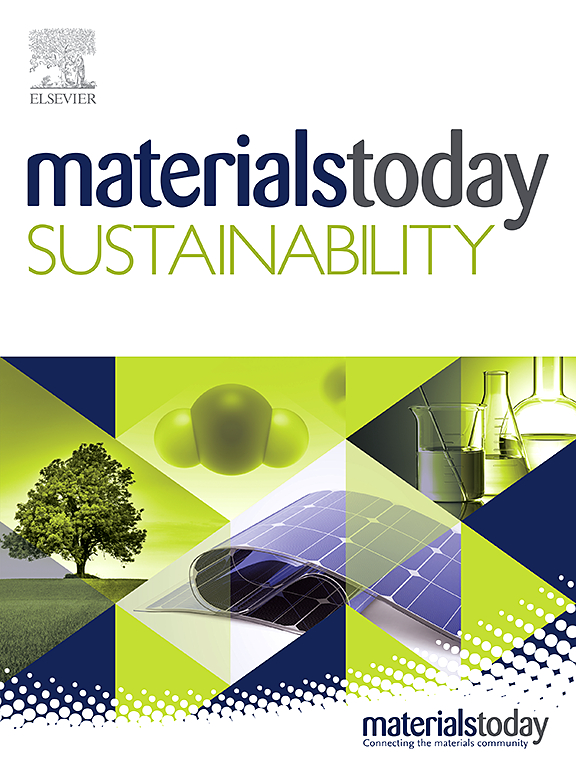Metal‐organic framework templated CoNi2S4 anchored MWCNT: A multifunctional application for photocatalysis, water splitting, and dye-sensitized solar cells
IF 7.9
3区 材料科学
Q1 GREEN & SUSTAINABLE SCIENCE & TECHNOLOGY
引用次数: 0
Abstract
The escalating energy crisis, dependence on non-renewable energy sources, and the need for efficient elimination of hazardous chemical compounds from water underscore the pressing demand for alternative renewable energy solutions and environmental protection techniques. Solar energy has developed as a feasible clean energy source, with electrochemical water splitting and photocatalytic water purification offering promising techniques for creating clean energy and tackling environmental challenges. This research presents an innovative hybrid catalyst, designated as ZIF-67-NC@CNS/MWCNT, which consists of N-doped Zeolite Imidazolate Framework-67 (ZIF-67) derived carbon and CoNi2S4 with Multi-Walled Carbon Nanotubes (MWCNT), utilizing a Metal-Organic Framework (MOF) as a template. This distinctive structure demonstrates exceptional multifunctional electrochemical performance in many applications, including Dye-Sensitized Solar Cells (DSSCs), Oxygen Evolution Reactions (OER), Hydrogen Evolution Reactions (HER), and photocatalytic degradation of tetracycline (TC). This composite, used as a counter electrode in DSSCs, attained a power conversion efficiency (PCE) of 6.35 %, a short-circuit current density (JSC) of 12.54 mA cm−2 and an open-circuit voltage (VOC) of 0.8 V. The observed increases may be ascribed to reduced peak-to-peak separation, lowered charge transfer resistance, shorter electron lifetimes, and greater exchange current density. The ZIF-67-NC@CNS/MWCNT composite exhibited remarkable bifunctional electrocatalytic activity, with overpotentials of 144 mV and 178 mV at 10 mA cm−2 for the OER and HER, respectively. Interestingly, the hybrid composite achieved the highest degradation efficiency of 97.56 % against TC under white light irradiation. The synergistic effect of metal sulfides and carbon materials can provide additional electron transmission paths and contact areas, leading to effective I3− reduction, reduced overpotential, and enhanced degradation efficiency. Consequently, the ZIF-67-NC@CNS/MWCNT hybrid functions as a proficient multifunctional electrocatalyst for many energy and environmental applications.

金属有机框架模板CoNi2S4锚定MWCNT:用于光催化、水分解和染料敏化太阳能电池的多功能应用
不断升级的能源危机,对不可再生能源的依赖,以及有效消除水中有害化合物的需要,强调了对替代可再生能源解决方案和环境保护技术的迫切需求。太阳能已经发展成为一种可行的清洁能源,电化学水分解和光催化水净化技术为创造清洁能源和应对环境挑战提供了有前途的技术。本研究提出了一种新型杂化催化剂ZIF-67-NC@CNS/MWCNT,它由n掺杂的咪唑酸分子筛框架-67 (ZIF-67)衍生碳和CoNi2S4与多壁碳纳米管(MWCNT)组成,利用金属有机框架(MOF)作为模板。这种独特的结构在染料敏化太阳能电池(DSSCs)、析氧反应(OER)、析氢反应(HER)和四环素(TC)的光催化降解等许多应用中展示了卓越的多功能电化学性能。该复合材料在DSSCs中用作对电极,功率转换效率(PCE)为6.35%,短路电流密度(JSC)为12.54 mA cm−2,开路电压(VOC)为0.8 V。观察到的增加可能归因于峰间分离减少,电荷转移电阻降低,电子寿命缩短和交换电流密度增大。ZIF-67-NC@CNS/MWCNT复合材料表现出显著的双功能电催化活性,OER和HER在10 mA cm−2下的过电位分别为144 mV和178 mV。在白光照射下,复合材料对TC的降解效率最高,达到97.56%。金属硫化物和碳材料的协同作用可以提供额外的电子传输路径和接触面积,从而有效地还原I3−,降低过电位,提高降解效率。因此,ZIF-67-NC@CNS/MWCNT的混合功能作为一个熟练的多功能电催化剂的许多能源和环境应用。
本文章由计算机程序翻译,如有差异,请以英文原文为准。
求助全文
约1分钟内获得全文
求助全文
来源期刊

Materials Today Sustainability
Multiple-
CiteScore
5.80
自引率
6.40%
发文量
174
审稿时长
32 days
期刊介绍:
Materials Today Sustainability is a multi-disciplinary journal covering all aspects of sustainability through materials science.
With a rapidly increasing population with growing demands, materials science has emerged as a critical discipline toward protecting of the environment and ensuring the long term survival of future generations.
 求助内容:
求助内容: 应助结果提醒方式:
应助结果提醒方式:


